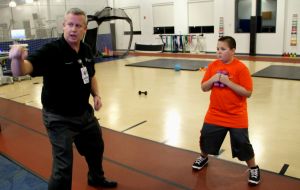There are many health effects that a patient may need to overcome after winning a battle against cancer. Cancer treatments can affect the patient’s balance, agility, coordination, prompt weight gain and other physical ailments. At Nationwide Children’s Hospital, beating cancer doesn’t mark the end of a child’s treatment regimen. A new exercise program at the hospital helps pediatric cancer survivors and those in remission regain both physical strength and confidence.
“Play Strong,” a pediatric cancer exercise program in partnership with the Sports Medicine and Oncology teams at Nationwide Children’s, is led by certified athletic trainers. The program was developed for cancer patients, 8-21-years-old, who are off treatment and have clearance from their physician. It is based on functional rehabilitation activities including flexibility, muscle strength, power, balance, agility and functional coordination.
Travis Gallagher, ATC, a certified athletic trainer in Sports Medicine at Nationwide Children’s, was key in implementing the program at the hospital.
“At a patient’s first session, we access their deficits and try to progress from there,” said Gallagher as he explained the goals of the Play Strong program. “We’re usually doing cardiovascular fitness, strength, power, agility and functional movement skills to get their bodies back into the motion of physical activity.”
Play Strong was designed for pediatric and adolescent cancer survivors to improve their motor skills and transition into physical activity safely. The goals are to improve muscle strength and power, balance and agility for better body coordination and self-confidence with all physical activities.
“While the kids have the heart and have the mind to get back into physical activity, once their chemotherapy is over, their bodies sometimes just aren’t ready,” said Randal Olshefski, MD chief of the Section of Hematology/Oncology/Bone Marrow Transplantation (BMT) at Nationwide Children’s Hospital, and also an associate professor of Pediatrics at The Ohio State University College of Medicine. “Play Strong is just another example of continuing to break through the barriers. We want the kids, safely, to get back to being as much of a kid as possible.”
Many pediatric cancer survivorship programs across the country encourage their patients to exercise and return to activity after a battle with cancer. But, only a few actually have a structured program similar to Nationwide Children’s.

The program was developed for cancer patients, 8-21-years-old, who are off treatment and have clearance from their physician.
